Meet 6 artists who work in charcoal and graphite
This story was featured in theApril 2017 issue of Southwest Art magazine. Get the Southwest Art April 2017 print issue or digital download now–then subscribe to Southwest Art and never miss another story.
Cole Johnson
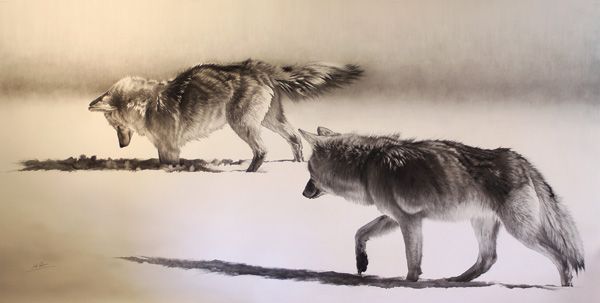
Cole Johnson, Coyotes Hunting, charcoal, 48 x 96.
After earning a bachelor of fine arts degree, New York artist Cole Johnson embarked on his own artistic explorations. “I’ve always been an avid sportsman,” he says. “I grew up in a sporting family, and I am an avid fly-fisherman.” Choosing graphite as his medium and studying the wildlife and animals in the fields and rivers where he spent his time, he created an evolving body of wildlife images. But his chosen medium wasn’t keeping pace with his vision, so, he says, “I started grinding my own graphite.” Then, to get the truly dark hues he needed for a full value scale, he incorporated charcoal as well.
Johnson’s atmospheric wildlife and animal drawings grew in size as his combinations of materials allowed him to cover larger surfaces. In a collaboration with gallery owner Greg Fulton of Astoria Fine Art, Johnson is pursuing his most ambitious work to date: life-size renderings of big game, from bison to bighorns. Limited only by the size of the frames—which Fulton sources—and available paper size, Johnson completed a solo show for the gallery featuring several of these 4-by-8-foot pieces, and collectors have responded.
He begins a piece by covering the white paper with a medium-gray tone. “Like gessoing a canvas,” he says. On that he works both positively, adding darker details, and negatively, wielding erasers to create lighter highlights. The overall effect brings his subjects to life. “I am passionate about art,” he says, “but about this genre in particular because of my love for the environment.”
Johnson’s work can be found at Astoria Fine Art, Jackson, WY; and Audubon Gallery, Charleston, SC. —Laura Rintala
Robin Cole Smith
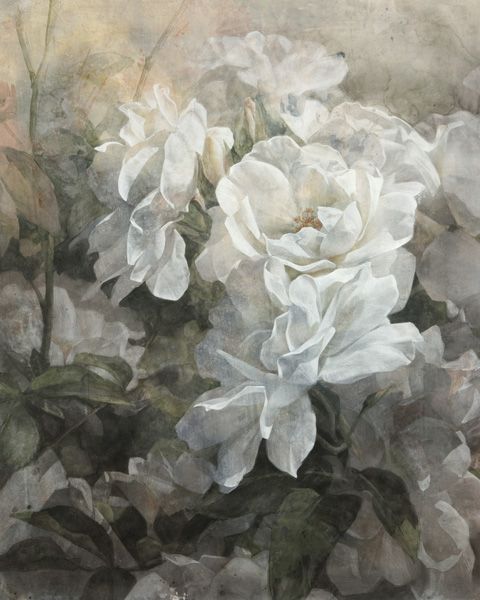
Robin Cole Smith, Abundance, mixed media, 50 x 40.
Using charcoal as her main medium, Robin Cole Smith depicts nature’s quiet, understated displays of beauty with the devotion of a field biologist. Among the artist’s subjects are tangled grasses, desert thistles, and a tattered wasps’ nest drawn from life. “The edge of realism is important to me, but the mood is where I come in,” says Smith, who typically uses photographs and her own imagined composition as a guide. “I want to represent the way subject matter appears to me.”
The Denver native and literary buff earned an English degree in 2007 with plans to become a high-school English teacher. But Smith soon felt another passion—drawing—tugging persuasively at her heartstrings. That passion steered her to a studio art program at the Burren College of Art in Ireland and later to the Laguna College of Art & Design in California, where she earned a master’s degree in fine art. Today Smith teaches writing and drawing at her alma mater, including its inaugural course in experimental drawing.
In her own creative process, Smith sometimes adds pastels, watercolors, and gouache to her monochromatic illustrations on hand-toned paper. One of her “primary love affairs,” she says, is working with layered encaustic. For these pieces, Smith completes drawings on translucent drafting vellum, then transfers them in layers onto a panel prepared with a traditional chalk ground and coats of wax that lift the charcoal pigment from the paper. “Whatever is in the foremost layer will read as sharper, darker, and warmer,” she explains, whereas objects deeper within are “cooler, softer, and cloudier,” as if receding.
See Smith’s work at Gallery 1261, Denver, CO, and Lora Schlesinger Gallery, Santa Monica, CA. —Kim Agricola
Sue deLearie Adair
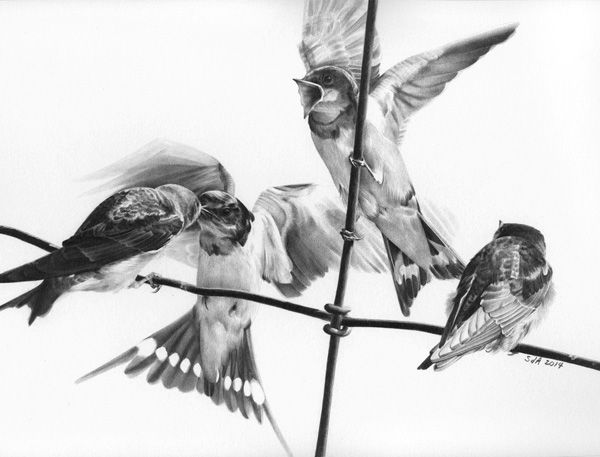
Sue deLearie Adair, Sibling Rivalry, graphite, 8 x 11.
New York artist Sue deLearie Adair says that after being an avid birdwatcher for over 30 years, she doesn’t know why she didn’t start drawing birds sooner. Adair joined her local Audubon Society chapter in her early 20s and found a love of nature and a passion for conservation. After a 25-year career in accounting and financial management, Adair decided to return to her artistic roots and found the birds were an endless source of inspiration.
Adair splits her time between her home in Schenectady, NY, and a cabin near Syracuse, NY, on the shores of Lake Ontario. She says the area is a favorite of hers during the migration season when scores of birds, of all different species, move across the landscape, offering prime birding opportunities. “The art has influenced the way I observe them, because I want to see them well, not just see them,” Adair says. She works mainly from photos taken on various hiking and birding trips, which she later combines and edits in Photoshop. “It’s really important for me to be doing my work from wild animals that I’ve seen in nature. There’s nothing wrong with zoos, but I like to be out there looking for the real thing,” Adair says.
While her main subjects, drawn in a combination of graphite and colored pencil, are tightly realistic and detailed, her backgrounds are often abstracted or vacant, serving as a stage for the primary actors and giving the entire piece a contemporary feel. Adair’s work can be found at Horizon Fine Art Gallery, Jackson, WY; Sackets Harbor Arts Center, Sackets Harbor, NY; South Street Art Gallery, Easton, MD; and www.suedelearieadair.com. —Mackenzie McCreary
John Coleman
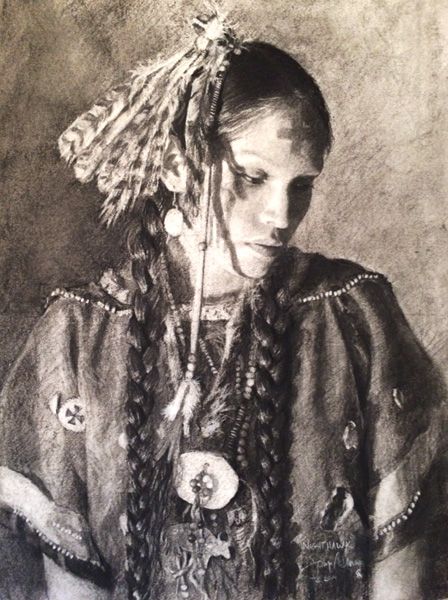
John Coleman, Night Hawk, charcoal, 17 x 12.
Decades before he took the western art world by storm as a sculptor, John Coleman wielded charcoal. The Prescott, AZ, artist’s foray into drawing began in high school and progressed to studies in life drawing at Chouinard Art Institute. Today Coleman, who also enjoys success as a painter, continues to revere the art form and often showcases his figurative drawings alongside his Native American-themed bronze sculptures and oils. Usually they complement those works and help cement a theme, he says, and sometimes good drawings inspire paintings, as FIRST CHIEF did.
In charcoal Coleman finds “a simple elegance” and a personality he likens to watercolors. “I let the material come out and do its thing,” he says. “The beauty of its translucency and the ghostly feeling of the paper coming through create a magical feeling.” Coleman develops multiple charcoal renditions of his models until one in particular “comes to life,” and he photographs his work to check for accuracy. But when his technique becomes too measured, he warns, replication can kill the life in a piece. “My interest is in moody atmosphere, light and shadow, hard edges and soft edges,” he says. “The more vague or ‘lyrical’ a piece is, the more others can see their own story in it.”
Coleman’s models wear items from his extensive collection of garments and artifacts, about half of which are antique and most of which reflect his focus on pre-Civil War, upper-Missouri Indian tribes. Any misstep in historical authenticity, he notes, risks waking viewers up from their dream. Find Coleman’s work at Legacy Gallery, Scottsdale, AZ, Jackson, WY, and Bozeman, MT; InSight Gallery, Fredericksburg, TX; and Plainsmen Gallery, Dunedin, FL. —Kim Agricola
William Harrison
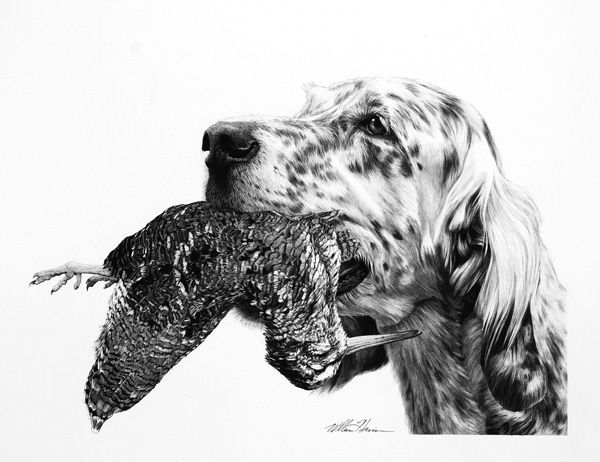
William Harrison, Jack, carbon pencils, 16 x 20.
When Photoshop software debuted in 1990, commercial artist William Harrison watched his career sink like a torpedoed ship. He spent three years reinventing himself, eventually earning his real estate license. He successfully sold real estate for a decade until the market crashed, and then he watched his second career follow the first. When life intervened and Harrison became the full-time caregiver to his aging mother-in-law, he found time to do the one thing he’d always loved: draw.
After decades of using a pen to create photo-realistic images made entirely of tiny dots, the artist gravitated toward highly detailed, realistic work. But this time he was working with charcoal, a medium that works up much faster than the stippling he’d done for so long.
Today, Harrison is known for intricate depictions of wildlife and sporting animals as well as people. “Everything I do is a portrait meant to reflect the essence of what I am drawing,” he says. “I want to focus in on the detail and say to people: ‘Look at this thing. Look at its inherent beauty.’” Harrison, who is happy to do commissions, is not married to any particular subject matter. Working exclusively from photographs, he looks for powerful images with contrasting lights and darks and, especially, interesting textures. “The bottom line is, I love the process of drawing. I don’t care what I draw, as long as it’s interesting. Drawing is my favorite thing to do.”
Harrison’s work is available at Cavalier Galleries, Greenwich, CT; Jean Albano Gallery, Chicago, IL; Paderewski Fine Art, Beaver Creek, CO; Trailside Galleries, Jackson, WY; and www.williamharrisonartist.com. —Laura Rintala
Lane Hall
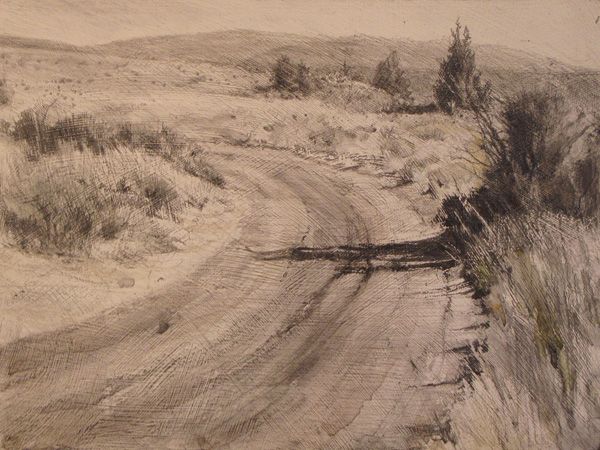
Lane Hall, Quiet, graphite, 6 x 10.
Lane Hall is widely known for his watercolor landscapes that combine realism with distinctive rough brushwork. But Hall recently remembered something he learned in art school. A professor in a figure-drawing class had the students paint gesso onto their thin poster paper. The application of gesso leaves behind stiff brush strokes that offer a unique texture to each drawing when graphite is applied on top of it. Today, Hall is beginning to experiment in the technique with rekindled interest.
When the artist began his return to graphite drawing, he focused on southwestern scenes. He was inspired by a visit to Utah, including a stop at Zion National Park. “These scenes just struck a chord with me,” Hall says. “I found a fondness for the high desert—there’s something about the dryness and vastness and the mystery of the rocks.”
Hall says he finds a certain amount of freedom in graphite. He uses several different weights of lead, often mixing it with water to create different values within the monochromatic medium. “Because there’s no color, it allows me to not have to worry about that,” he says. “I can just go right into the drawing, the texture, and the value aspect. It helps me to be expressive within the confines of the realism.” Hall’s work can be found at Total Arts Gallery, Taos, NM; Marta Stafford Fine Art, Marble Falls, TX; and www.lanehallart.com.
This story was featured in theApril 2017 issue of Southwest Art magazine. Get the Southwest Art April 2017 print issue or digital download now–then subscribe to Southwest Art and never miss another story.
MORE RESOURCES FOR ART COLLECTORS & ENTHUSIASTS
• Subscribe to Southwest Art magazine
• Learn how to paint & how to draw with downloads, books, videos & more from North Light Shop
• Sign up for your Southwest Art email newsletter & download a FREE ebook





